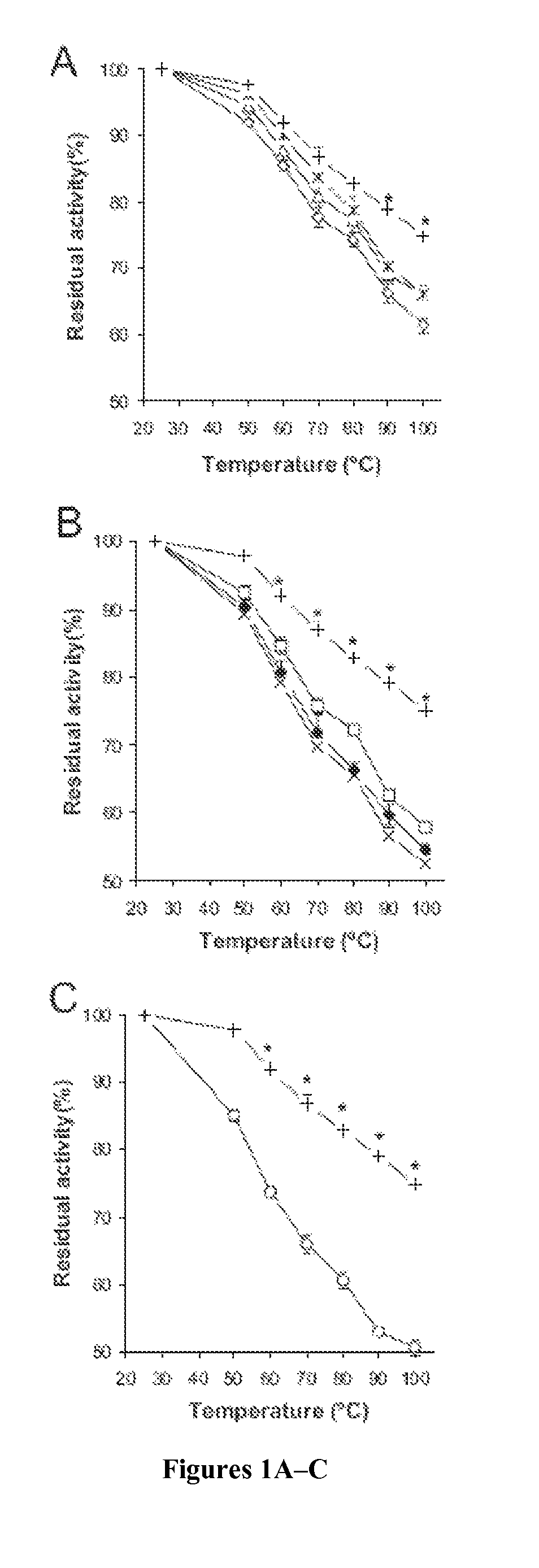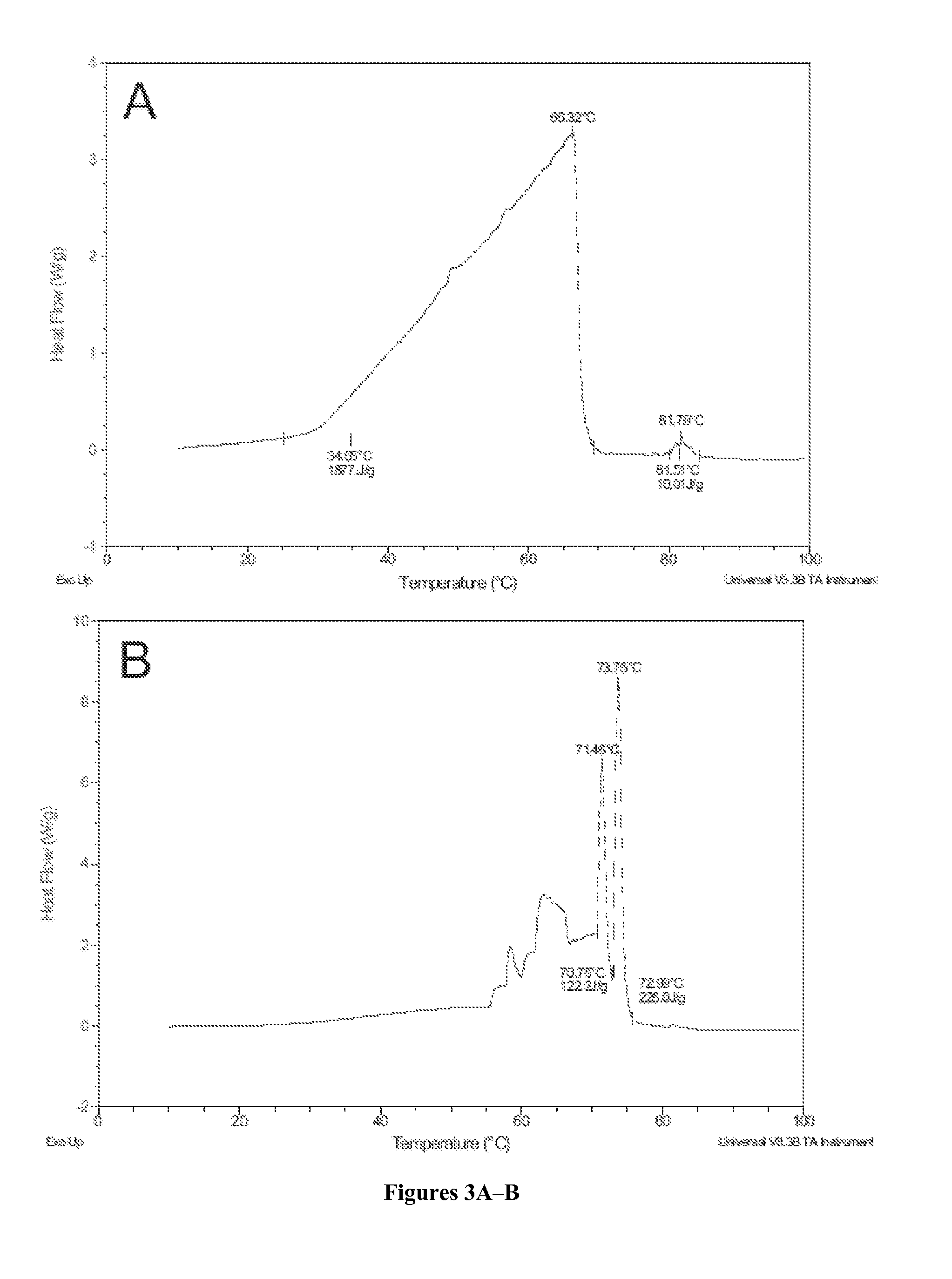Mutants of Aspergillus niger PhyA phytase and Aspergillus fumigatus phytase
a technology of aspergillus niger and phytase, which is applied in the field of mutants of i > aspergillus niger /i > phya phytase and i > aspergillus fumigatus /i > phytase, can solve the problems that none of the natural phytases, including the commercially available phytases, can meet th
- Summary
- Abstract
- Description
- Claims
- Application Information
AI Technical Summary
Benefits of technology
Problems solved by technology
Method used
Image
Examples
example 1
Media and Reagents
[0124]Bacterial and yeast strains, plasmids, and primers used in Examples 1-14 are listed in Table 2. Escherichia coli DH5α was cultured at 37° C. in LB medium. Pichia pastoris X33 was cultured at 30° C. in either YPD medium or BMGY / BMMY medium (Invitrogen, San Diego, Calif.). Zeocin (Invitrogen, San Diego, Calif.) was added at 100 μg ml−1 YPD medium or BMGY / BMMY medium for yeast and 25 ug ml−1 LB medium for E. coli. Restriction enzymes were obtained from Promega (Madison, Wis.). Oligonucleotides were synthesized at MWGbiotech (High Point, N.C.). Phytic acid (inositol hexaphosphoric acid) dodecasodium salt from rice (p-3138), ammonium molybdate tetrahydrate (A-7302), and L-ascorbic acid (A-0278) were purchased from Sigma (St. Louis, Mo.). Sulfuric acid (A300-212) and trichloroacetic acid (A322) were purchased from Fisher (Pittsburgh, Pa.). Automatic DNA sequencing was performed at Cornell Biotechnology Center.
[0125]
TABLE 2Strains, plasmids and synthetic oligonucleo...
example 2
Rational Design of Mutations
[0126]To assess the contributions of E35, R168, and R248 involved in hydrogen bonding and ionic interactions to the thermostability of Afp, site-directed mutagenesis was used to substitute each of these three residues with alanine so they would no longer participate in the predicted interactions. A total of 7 mutants were constructed, including three single-substitution mutants (Afp-E35A, Afp-R168A, and Afp-R248A), three double-substitution mutants (Afp-E35A / R168A, Afp-R168A / R248A, and Afp-E35A / R248A), and one triple-substitution mutant (Afp-E35A / R168A / R248A).
[0127]To test whether the thermostability of PhyA could be improved by adopting the putative hydrogen bonding and ionic interactions of Afp, residues A58, P65, Q191, and T271 of PhyA were substituted with the corresponding Afp residues (Glu, Ser, Arg, and Arg, respectively). Pro65 of PhyA was changed to Ser in order to form a hydrogen bonding network with Glu58 as in the corresponding position of Afp...
example 3
Site-Directed Mutagenesis
[0128]Site-directed mutagenesis of A. fumigatus afp and of A. niger phyA genes was conducted using mega-primer polymerase chain reaction (“PCR”) mutagenesis. Briefly, DNA fragments containing the desired point mutations were produced in two sequential PCR. The first reaction used a 22-25 nucleotide primer containing a single nucleotide alteration (Table 2) and a 22-25 nucleotide reverse primer. The resulting PCR products were size-fractionated using 1.5% agarose gel and purified using QIAquick gel extraction kit (Qiagen, Valencia, Calif.). These PCR fragments were then used as mega-primers in a second PCR, along with a forward primer. These second PCR products were then digested at each end by two restriction enzymes and introduced into the wild type template to replace the corresponding wild type gene fragments. The double and triple mutations were generated by splicing the template containing the single mutations after restriction enzyme digestions and com...
PUM
| Property | Measurement | Unit |
|---|---|---|
| temperature | aaaaa | aaaaa |
| pH | aaaaa | aaaaa |
| melting temperature | aaaaa | aaaaa |
Abstract
Description
Claims
Application Information
 Login to View More
Login to View More - R&D
- Intellectual Property
- Life Sciences
- Materials
- Tech Scout
- Unparalleled Data Quality
- Higher Quality Content
- 60% Fewer Hallucinations
Browse by: Latest US Patents, China's latest patents, Technical Efficacy Thesaurus, Application Domain, Technology Topic, Popular Technical Reports.
© 2025 PatSnap. All rights reserved.Legal|Privacy policy|Modern Slavery Act Transparency Statement|Sitemap|About US| Contact US: help@patsnap.com



